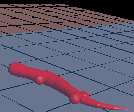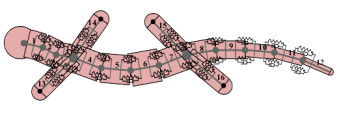Lamprey

This project investigates the anguiliform swimming of the lamprey, one of the earliest vertebrates. Following the work of Örjan Ekeberg, we developed a neuromechanical simulation of the lamprey (i.e. a simulation composed of both a neural network and a biomechanical model) to investigate the functioning of central pattern generators for swimming. This project uses genetic algorithms to automatically design part of the neural networks given a description of the desired behavior of the complete system. This approach has many interesting properties both for computational neuroscience —by fitting a model to biological data, and automatically setting parameters instead of hand-tuning them— and for robotics —by optimizing a controller in terms of speed of swimming, or ability to induce turning, for instance.
Central pattern generator models inspired from the lamprey are currently used in Amphibot, our amphibious snake/lamprey robot.
People involved: Alessandro Crespi, Auke Ijspeert
Sample animations/movies

Biological controller: Figure
Neuron model: Figure
Real number genetic algorithm: Figure
Example of evolved swimming controller: Figure
Swimming and neural activity: Animation
Lamprey turning: Animation
Swimming against a speed barrier WITHOUT sensory feedback: Animation
Swimming against a speed barrier WITH sensory feedback: Animation
Tracking a randomly moving object: Animation
Different types of swimming during the evolutions: avi, avi, avi
Salamander
This project investigates the transition from swimming to walking during vertebrate evolution.
In collaboration with Jean-Marie Cabelguen, a neurophysiologist at the University of Bordeaux (France), we study whether neural controllers for swimming similar to those of the lamprey (a primitive fish, see the lamprey locomotion page) can be extended to control both the swimming and walking of the salamander. The salamander is indeed believed to be one of the modern tetrapods closest to the first vertebrate having made the transition from aquatic to terrestrial habitats during evolution. Using a neuromechanical simulation of the salamander (i.e. a simulation which combines a mechanical model of the body and a neural network model of the locomotor central pattern generator), we investigate several organizations of neural networks capable of producing the typical swimming and walking gaits of the salamander.
We have developed two types of numerical models: (1) based on leaky-integrator neural networks (e.g. Biological Cybernetics 2001) and (2) based on systems of coupled nonlinear oscillators (e.g. NeuroInformatics 2005). Our models give insights into how the different oscillatory centers identified in the spinal cord are coupled together to produce the bi-modal salamander locomotion, and how driving signals from the upper part of the brain can modulate speed, direction, and type of gait. The models replicate some key characteristics of salamander locomotion, in particular the production of body undulations in traveling wave mode for swimming, and in standing wave mode coordinated with limb movements for walking.
Please check out the latest model implemented in the robot Salamandra robotica.
People involved: Alessandro Crespi, Auke Ijspeert
Sample animations/movies 
ollowing_target(20MB).avi
following_target_divx(3MB).avi
swimming_to_walking(6MB).avi
swimming_to_walking_divx(1.6MB).avi
walking_speed_direction(11MB).avi
walking_speed_direction_divx(2MB).avi
frustration(14MB).avi
frustration_divx(3MB).avi
dynamic_environment(29MB).avi
dynamic_environment_divx(4MB).avi
Related student projects
- A salamander Java applet compatible with Java 1.1, Stephan Singh (Semester project 2003-2004)
- Analysis of hydrodynamic forces on a swimming salamander model, Anurag Tripathi (Summer Internship 2003)
- Java applet of the salamander neuromechanical simulation, Sébastien Catherinet (Diploma project 2002-2003)
- Artificial evolution of locomotion controllers for the salamander, Stéphane Rossi (Summer Internship 2003)